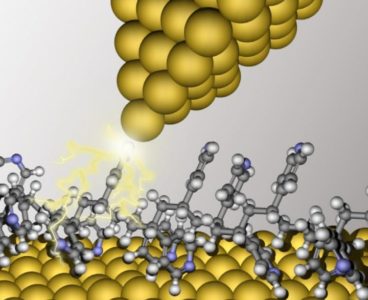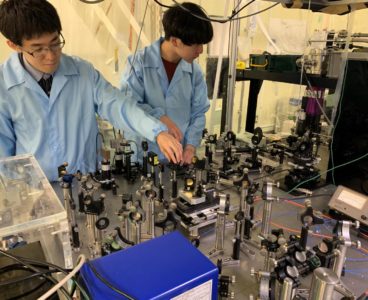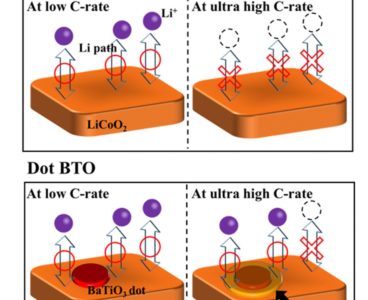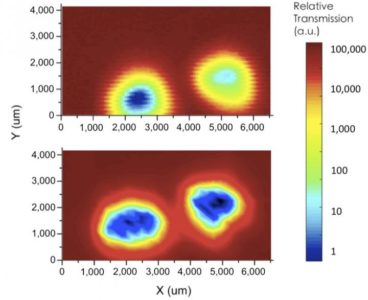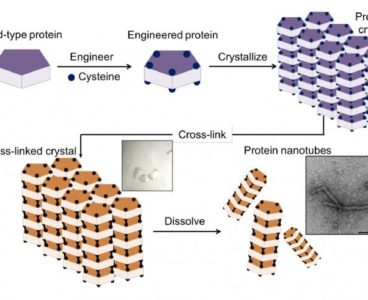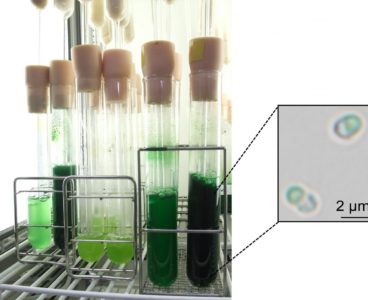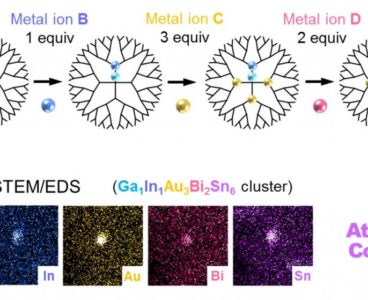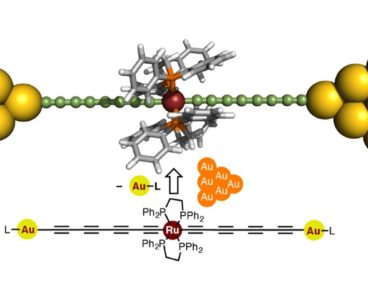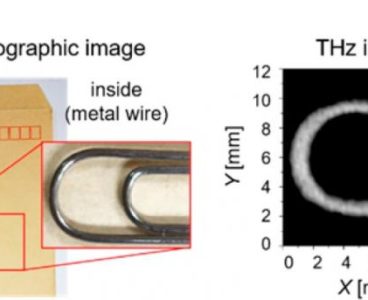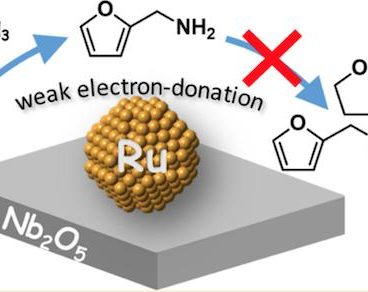Scientists at Tokyo Institute of Technology and University of Tsukuba demonstrate that polymers could play a key role in the fabrication of single-molecule electronic devices, allowing us to push the boundaries of the nanoelectronics revolution. One of the most striking aspects of the electronic devices we have today is their size and the size of…
A Light Matter: Understanding the Raman Dance of Solids
Scientists at Tokyo Institute of Technology and Keio University investigated the excitation and detection of photogenerated coherent phonons in polar semiconductor GaAs through an ultrafast dual pump-probe laser for quantum interferometry. Imagine a world where computers can store, move, and process information at exponential speeds using what we currently term as waste vibrations–heat and noise.…
Nanosized Container with Photoswitches Jettisons Cargo upon Irradiation
Researchers at Tokyo Tech have developed a nanosized container bearing photoswitches that takes up hydrophobic compounds of various size and shape in water and subsequently releases them quantitatively by non-invasive light stimulus. The installed switches allow reusing of the container after successful release of the cargo. The novel system represents a versatile platform for future…
A New Path to Achieving Invisibility without the Use of Metamaterials
A pair of researchers at Tokyo Institute of Technology (Tokyo Tech) describes a way of making a submicron-sized cylinder disappear without using any specialized coating. Their findings could enable invisibility of natural materials at optical frequency and eventually lead to a simpler way of enhancing optoelectronic devices, including sensing and communication technologies. Making objects invisible…
Scientists Discover Deep microbes’ Key Contribution to Earth’s Carbon Cycle
Hydrocarbons play key roles in atmospheric and biogeochemistry, the energy economy, and climate change. Most hydrocarbons form in anaerobic environments through high temperature or microbial decomposition of organic matter. Microorganisms can also “eat” hydrocarbons underground, preventing them from reaching the atmosphere. Using a new technique developed at the Earth-Life Science Institute (ELSI), an international team…
Elucidation of Structural Property in Li-Ion Batteries that Deliver Ultra-Fast Charging
Scientists at Tokyo Tech and Okayama University found a way of greatly improving the performance of LiCoO2 cathodes in Li-ion batteries by decorating them with BaTiO3 nanodots. Most importantly, they elucidated the mechanism behind the measured results, concluding that the BaTiO3 nanodots create a special interface through which Li ions can circulate easily, even at…
Scientists Develop a Tunable Bio-Imaging Device Using Terahertz Plasmonics
Researchers at Tokyo Institute of Technology (Tokyo Tech) have developed an easy-to-use, tunable biosensor tailored for the terahertz range. Images of mouse organs obtained using their new device verify that the sensor is capable of distinguishing between different tissues. The achievement expands possibilities for terahertz applications in biological analysis and future diagnostics. Plasmonics are highly…
Green Catalysts with Earth-Abundant Metals Accelerate Production of Bio-Based Plastic
Scientists at Tokyo Institute of Technology (Tokyo Tech) have developed and analyzed a novel catalyst for the oxidation of 5-hydroxymethyl furfural, which is crucial for generating new raw materials that replace the classic non-renewable ones used for making many plastics. It should be no surprise to most readers that finding an alternative to non-renewable natural…
Electronics of the Future: A New Energy-Efficient Mechanism Using the Rashba Effect
Scientists at Tokyo Institute of Technology proposed new quasi-1D materials for potential spintronic applications, an upcoming technology that exploits the spin of electrons. They performed simulations to demonstrate the spin properties of these materials and explained the mechanisms behind their behavior. Conventional electronics is based on the movement of electrons and mainly concerns their electric…
Nanotubes Built From Protein Crystals: Breakthrough in Biomolecular Engineering
Researchers at Tokyo Institute of Technology (Tokyo Tech) have succeeded in constructing protein nanotubes from tiny scaffolds made by cross-linking of engineered protein crystals. The achievement could accelerate the development of artificial enzymes, nano-sized carriers and delivery systems for a host of biomedical and biotechnological applications. An innovative way for assembly of proteins into well-ordered…
Scientists Find a ‘Switch’ to Increase Starch Accumulation in Algae
Results from a collaborative study by Tokyo Institute of Technology and Tohoku University, Japan, raise prospects for large-scale production of algae-derived starch, a valuable bioresource for biofuels and other renewable materials. Such bio-based products have the potential to replace fossil fuels and contribute to the development of sustainable systems and societies. A “switch” controlling the…
Breakthrough in Blending Metals
Researchers in Japan have found a way to create innovative materials by blending metals with precision control. Their approach, based on a concept called atom hybridization[1], opens up an unexplored area of chemistry that could lead to the development of advanced functional materials. Background Multimetallic clusters — typically composed of three or more metals —…
Sensor Provides Real-time Oxygen Level Info
Based on a protein from E. coli, scientists at Tokyo Tech have developed a fluorescent protein sensor able to provide real-time information on dynamic changes in oxygen levels with very high sensitivity. As the oxygen level is a major determinant of cellular function, the idea behind this sensor may revolutionize our ability to detect cellular…
New Molecular Wires for Single-Molecule Electronic Devices
Scientists at Tokyo Institute of Technology designed a new type of molecular wire doped with organometallic ruthenium to achieve unprecedentedly higher conductance than earlier molecular wires. The origin of high conductance in these wires is fundamentally different from similar molecular devices and suggests a potential strategy for developing highly conducting “doped” molecular wires. Since their…
Scientists Identify Enzyme That Could Help Accelerate Biofuel Production
Scientists Fine-Tune Carbon Nanotubes for Flexible, Fingertip-Wearable Terahertz Imagers
Researchers at Tokyo Institute of Technology have developed flexible terahertz imagers based on chemically “tunable” carbon nanotube materials. The findings expand the scope of terahertz applications to include wrap-around, wearable technologies as well as large-area photonic devices. Carbon nanotubes (CNTs) are beginning to take the electronics world by storm, and now their use in terahertz…
Reducing Carbon Dioxide With Common Elements and Sunlight
An international collaborative research group including Tokyo Institute of Technology, Universite PARIS DIDEROT and CNRS has discovered that CO2 is selectively reduced to CO[1] when a photocatalyst[2] composed of an organic semiconductor material and an iron complex is exposed to visible light. They have made clear that it is possible to convert CO2, the major…
Study Reveals Simple Chemical Process That May Have Led to the Origin of Life on Earth
Research led by Kuhan Chandru and Jim Cleaves from the Earth-Life Science Institute at Tokyo Institute of Technology, Japan, has shown that reactions of alpha-hydroxy acids, similar to the alpha-amino acids that make up modern proteins, form large polymers easily under conditions presumed prevalent on early Earth. These alpha-hydroxy acid polymers may have aided in…
Micro-Thermometer Tracks Miniscule Temperature Changes
Scientists at Tokyo Institute of Technology (Tokyo Tech) and their collaborators in Swinburne University of Technology have developed a micrometer-wide thermometer that is sensitive to heat generated by optical and electron beams, and can measure small and rapid temperature changes in real time. This new device can be used to explore heat transport on the…
Non-Toxic Filamentous Virus Rapidly Dissolves Heat from Electronics
The researcher team of Tokyo Tech discovered that the film constructed by assembling a nontoxic filamentous virus functions as a heat dissipation material, and that can be simply prepared by drying the virus aqueous solution at room temperature. This discovery is expected to elucidate the mechanism of new heat transport in electronics. Organic polymeric materials…
Monocrystalline Silicon Thin Film for Cost-Cutting Solar Cells with 10-Times Faster Growth Rate Fabricated
A research team from Tokyo Institute of Technology (Tokyo Tech) and Waseda University have successfully produced high-quality thin film monocrystalline silicon with a reduced crystal defect density down to the silicon wafer level at a growth rate that is more than 10 times higher than before. In principle, this method can improve the raw material…
Novel New Approach for Developing Semiconductors
Scientists at Tokyo Institute of Technology and their team involving researchers of JASRI, Osaka University, Nagoya Institute of Technology, and Nara Institute of Science and Technology have just developed a novel approach to determine and visualize the three-dimensional (3-D) structure of individual dopant atoms using SPring-8. The technique will improve the current understanding of the…
Superconductivity Found in Thin Films of Titanium Oxide
Many of us are familiar with titanium dioxide (TiO2), a whitener commonly used in sunscreens and paints such as the white lines seen on tennis courts. Less well known are other higher titanium oxides — those with a higher number of titanium and oxygen atoms than TiO — that are now the subject of intensifying…
Nanocapsule Perfectly Binds Sucrose in Water
Scientists around the world are pursuing the goal of developing synthetic receptors capable of recognizing biologically important molecules. Although many attempts have been made to mimic the way that protein pockets detect sugar dissolved in water with hydrogen bonding interactions, few have succeeded, mainly due to the interfering nature of water molecules. Now, a Japanese…
Reusable Ruthenium-Based Catalyst Could Be a Game-Changer for the Biomass Industry
Known for their outstanding versatility, primary amines (derivatives of ammonia) are industrially important compounds used in the preparation of a wide range of dyes, detergents and medicines. Although many attempts have been made to improve their synthesis using catalysts containing nickel, palladium and platinum, for example, few have succeeded in reducing the formation of secondary…

